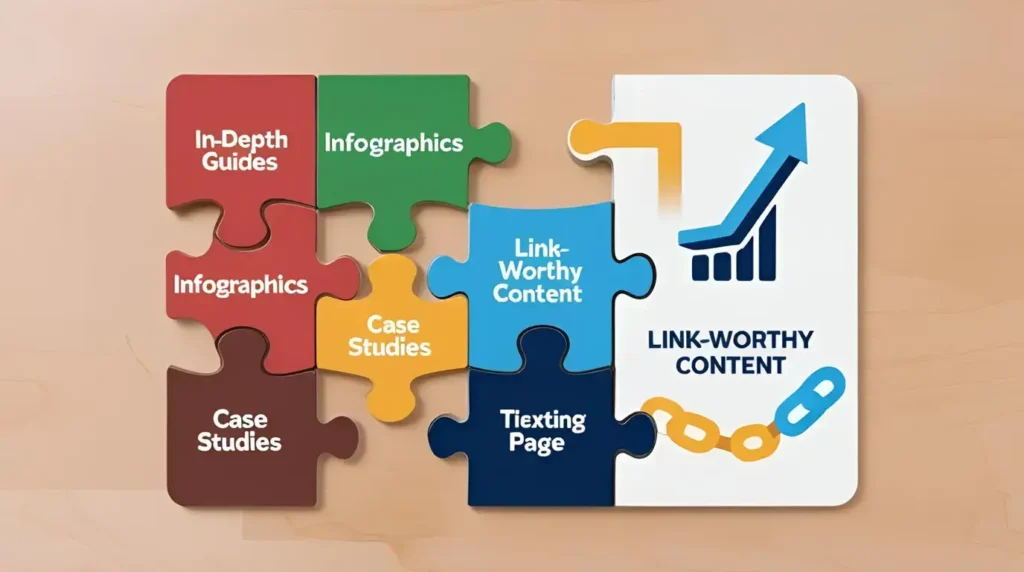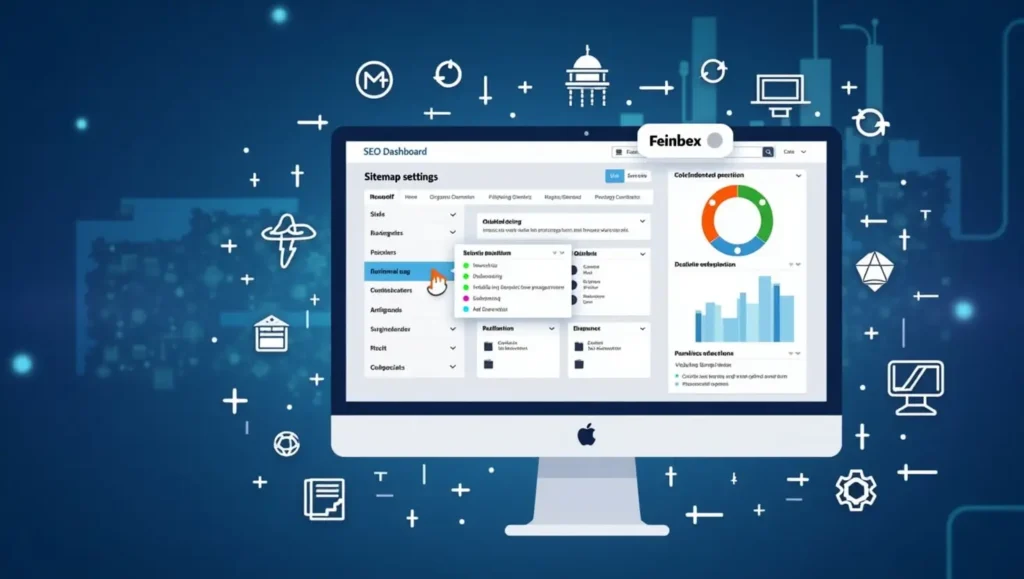Did you know that websites with a strong backlink profile generate 67% more leads than those without? In the fast-paced and ever-evolving world of SEO, link- worthy content is the golden ticket to boosting your website’s authority, driving organic traffic, and climbing search engine rankings. But what exactly makes content link-worthy? And how can you create content that not only attracts backlinks but also resonates with your audience while following white hat link-building practices?
In this blog, we’ll dive into 7 proven strategies to create high-quality, link-worthy content that stands out in the competitive digital landscape. Whether you’re a seasoned marketer or just starting out, these ethical, white-hat techniques will help you craft content that earns authoritative backlinks, engages readers, and drives long-term SEO success.

Why Link-Worthy Content Matters for SEO
Before we dive into the strategies, let’s understand why link-worthy content is crucial for SEO success. According to a recent study by Ahrefs, websites with a higher number of quality backlinks tend to rank higher on Google.
Search engines receive backlinks from other websites as a vote of confidence that your material is reliable and valuable.
However, not all content is created equal. To earn backlinks, your content must be:
- Original and unique: Stand out from the crowd by offering fresh perspectives or innovative ideas.
- In-depth and well-researched: Provide comprehensive information that answers your audience’s questions thoroughly.
- Actionable and valuable: Offer practical tips, tools, or solutions that readers can implement immediately.
- Visually appealing and shareable: Use visuals like infographics, charts, or videos to make your content more engaging.
7 Proven Ways to Create Link Worthy Content

Now, let’s explore the 7 proven ways to create link-worthy content that ticks all these boxes.
1. Create In-Depth Guides and Tutorials
One of the most effective ways to create link-worthy content is by publishing in-depth guides or tutorials. These resources provide immense value to your audience by addressing their pain points and offering step-by-step solutions.
Why It Works:
- Comprehensive content ranks higher on search engines. Google prioritizes content that thoroughly covers a topic, as it provides more value to users.
- Other websites are more likely to link to authoritative guides as references. When your content is seen as a go-to resource, it naturally attracts backlinks.
Example:
A blog post titled “The Ultimate Guide to SEO in 2024: Step-by-Step Strategies for Success” can attract backlinks from industry blogs, forums, and educational websites. This type of content is highly shareable because it offers actionable insights that readers can apply to their own strategies.
Actionable Tip:
Use tools like Google Keyword Planner or Ahrefs to identify topics with high search volume and low competition. Look for gaps in existing content and create guides that fill those gaps.
Pro Tip:
Break down your guide into sections with clear subheadings (H2, H3) for better readability. To draw attention to important points, use bold writing, numbered lists, and bullet points. Additionally, include checklists, templates, or downloadable resources to add extra value. For example, if you’re writing a guide on SEO, provide a downloadable checklist for on-page optimization.
Real-Life Example:
Imagine you’re writing a guide on “How to Start a Blog in 2024.” Instead of just listing steps, include:
- A step-by-step tutorial with screenshots.
- A free blog setup checklist.
- Links to recommended tools and resources.
This approach not only makes your content more valuable but also increases the likelihood of other websites linking to it as a reference.
2. Leverage Data-Driven Insights and Original Research
Content backed by data and original research is highly link-worthy because it provides unique insights that aren’t available elsewhere. In a world where information is abundant, data-driven content stands out by offering fresh, credible, and actionable insights.
Why It Works:
- Data-driven content is seen as more credible and authoritative. When you present facts, statistics, or research findings, your content becomes a trusted resource.
- Other websites and journalists often cite original research in their articles. This not only earns you backlinks but also positions your brand as a thought leader in your industry.
Example:
Publish a report titled “2024 Content Marketing Trends: Insights from 500+ Marketers” and share key findings with industry publications. For instance, if your research reveals that 70% of marketers plan to increase their video marketing budgets in 2024, this statistic could be widely cited across blogs, news outlets, and social media.
Actionable Tip:
Conduct surveys or analyze industry data using tools like SurveyMonkey or Google Analytics. For example, if you run an e-commerce business, analyze customer behavior data to identify trends like “most popular product categories” or “peak shopping hours.”
Pro Tip:
Visualize your data using charts, graphs, or infographics to make it more engaging and shareable. For instance, turn your survey results into a visually appealing infographic that summarizes key findings in a digestible format.
3. Craft Engaging Infographics and Visual Content
Visual content like infographics and data visualizations is highly shareable and link-worthy. According to Venngage, infographics are 3x more likely to be shared than other types of content.
Why It Works:
- Complex material is made easier to understand through the use of visuals. For example, an infographic explaining “How SEO Works” can break down technical concepts into simple, visually appealing steps.
- Websites often embed infographics in their articles, providing a natural backlink. When other sites use your visuals, they typically link back to your website as the source.
Example:
Create an infographic titled “The Anatomy of a Perfect Blog Post: A Visual Guide” and promote it to bloggers and marketers. This infographic could include elements like ideal word count, keyword placement, and the importance of visuals, making it a go-to resource for content creators.
Actionable Tip:
Use tools like Canva or Piktochart to design professional infographics. These tools offer templates and drag-and-drop features, making it easy to create visually stunning content even if you’re not a designer.
Pro Tip:
Include a short introduction and key takeaways with your infographic to make it more informative and link-worthy. For example, pair your infographic with a blog post that explains the data in detail and provides actionable tips.
4. Publish Case Studies and Success Stories
Case studies are powerful link-worthy content because they showcase real-life examples of success. They demonstrate your expertise and provide actionable insights for your audience.
Why It Works:
- Case studies build trust and credibility. When you share real-world examples of how your product or service solved a problem, it resonates with potential customers.
- Other websites link to case studies as proof of concepts or examples. For instance, a digital marketing agency might link to your case study to illustrate the effectiveness of a specific strategy.
Example:
A case study titled “How We Increased Organic Traffic by 300% in 6 Months” can attract backlinks from industry blogs and forums. This case study could detail the challenges faced, the strategies implemented, and the results achieved, providing a roadmap for others to follow.
Actionable Tip:
Include before-and-after data, screenshots, and testimonials to make your case study more compelling. For example, if you helped a client increase their website traffic, include graphs showing the traffic growth and quotes from the client praising your work.
Pro Tip:
Use a storytelling format to make your case study more engaging. Highlight the problem, solution, and results in a narrative style. For instance, start with the client’s pain points, describe how you addressed them, and conclude with the measurable outcomes.
5. Write Listicles and Curated Resources
Listicles (list-based articles) and curated resources are highly shareable and link-worthy because they provide value in an easy-to-digest format.
Why It Works:
- Listicles are scannable and engaging. Readers love numbered lists because they’re easy to skim and provide quick takeaways.
- Curated resources save time for readers, making them more likely to share and link. For example, a list of “Top 10 Free SEO Tools” is a valuable resource that bloggers and marketers will reference and share.
Example:
A blog post titled “10 Free SEO Tools Every Marketer Should Use in 2025” can attract backlinks from tool directories and resource pages. This type of content is evergreen, meaning it remains relevant and valuable over time.
Actionable Tip:
Use tools like BuzzSumo to identify trending topics and create listicles around them. For instance, if “AI tools for content creation” is a hot topic, create a listicle like “15 AI Tools to Supercharge Your Content Marketing.”
Pro Tip:
Add a brief description for each item in your listicle to provide more context and value. For example, instead of just listing tools, explain how each tool works and why it’s useful.
6. Solve Specific Problems or Answer Common Questions
Content that solves specific problems or answers common questions is highly link-worthy because it addresses real audience needs. When your content provides actionable solutions, it becomes a go-to resource for readers and other websites alike.
Why It Works:
- Problem-solving content is highly relevant and valuable. It directly addresses the pain points of your audience, making it more likely to be shared and linked to.
- Websites often link to such content as a reference for their readers. For example, a blog post about fixing SEO errors can be linked to by forums, Q&A sites, and even competitors looking to provide additional resources.
Example:
A blog post titled “How to Fix Common SEO Errors in 2024” can attract backlinks from forums like Reddit, Q&A platforms like Quora, and even other blogs in your niche. This type of content is evergreen, meaning it remains relevant and valuable over time.
Actionable Tip:
Use tools like AnswerThePublic or Quora to identify common questions in your niche. For instance, if you notice many people asking, “Why is my website not ranking on Google?” Create a detailed guide addressing this issue.
Pro Tip:
Include step-by-step instructions or video tutorials to make your content more actionable. For example, if you’re writing about fixing SEO errors, provide screenshots or a video walkthrough to help readers implement your advice.
7. Collaborate with Industry Experts and Influencers
Collaborating with industry experts and influencers can make your content more authoritative and link-worthy. When you involve recognized voices in your field, your content gains credibility and reach.
Why It Works:
- Expert opinions add credibility to your content. Readers are more likely to trust and share content that includes insights from well-known figures in your industry.
- Influencers are more likely to share and link to content they’ve contributed to. This not only increases your content’s visibility but also earns you valuable backlinks.
Example:
Publish a roundup post titled “10 SEO Experts Share Their Top Tips for 2025” and ask the contributors to share it with their audience. This type of content is highly shareable because it features multiple experts, each with their own following.
Actionable Tip:
Reach out to experts via LinkedIn or email and invite them to contribute to your content. Be clear about the value they’ll gain, such as exposure to your audience or a backlink to their website.
Pro Tip:
Include a short bio and social media links for each expert to encourage them to share the content. For example, after featuring an expert’s tip, add a line like, “Follow [Expert Name] on Twitter for more insights on…”
By focusing on problem-solving content and collaborating with experts, you can create content that not only attracts backlinks but also builds trust and authority. These strategies ensure your content is both valuable and shareable, helping you achieve long-term SEO success.
Additional Tips for Creating Link-Worthy Content
While the above strategies are highly effective, here are a few additional tips to ensure your content stands out:
1. Optimize for SEO
- Use primary keywords like “link-worthy content naturally throughout your blog.
- Include secondary keywords like “how to create a link for SEO and “what makes a good link in SEO” in subheadings and body content.
- Optimize meta descriptions, alt text, and URLs for better search engine visibility.
2. Promote Your Content
- Share your content on social media platforms like LinkedIn, Twitter, and Facebook.
- Use email marketing to reach out to your subscribers and encourage them to share your content.
- Engage in online communities and forums to promote your content organically.
3. Update Old Content
- Regularly update your old blog posts with new information, statistics, and insights.
- Add new sections, visuals, or case studies to make your content more relevant and link-worthy.
4. Monitor Backlinks
- Track your backlinks and find areas for development with tools like Ahrefsor SEMrush.
- Reach out to websites that have linked to similar content and pitch your blog as a better resource.
Conclusion: Start Creating Link-Worthy Content Today
Creating link-worthy content is not just about earning backlinks—it’s about providing real value to your audience. By following the 7 proven strategies outlined in this blog, you can craft content that stands out, attracts links, and drives SEO success.
The key to creating link-worthy content lies in:
- Originality and uniqueness: Stand out by offering fresh perspectives and innovative ideas.
- In-depth research and data-driven insights: Back your content with credible data and original research.
- Solving specific problems: Address your audience’s pain points with actionable solutions.
- Collaborating with experts: Leverage the authority of industry leaders to boost your content’s credibility.
From in-depth guides and infographics to case studies and expert collaborations, these strategies ensure your content is both valuable and shareable. Additionally, optimizing for SEO, promoting your content, updating old posts, and monitoring backlinks will help you maximize its reach and impact.
Start implementing these strategies today, and watch your website’s authority and traffic soar. Remember, consistency is key—keep creating, promoting, and refining your content to stay ahead in the competitive world of SEO.
Ready to take your content to the next level? Begin crafting link-worthy content today and see the results for yourself!
FAQs
1. How do I create a link for SEO?
To create a link for SEO, focus on creating high-quality, link-worthy content that other websites want to reference. Use internal linking within your site and outreach strategies to earn backlinks from external sources.
2. How to build 100 backlinks in 30 days or less?
Building 100 backlinks in 30 days requires a combination of strategies like guest posting, broken link building, and outreach campaigns. Focus on creating valuable content that others want to link to and actively promote it to relevant websites.
3. What makes a good link in SEO?
A good link in SEO comes from a high-authority website, is relevant to your niche, and uses natural anchor text. Avoid spammy or low-quality links, as they can harm your SEO efforts.
4. What is link-worthy content?
Link-worthy content is original, valuable, and shareable content that other websites want to reference and link to. It often includes in-depth guides, data-driven research, infographics, and case studies.
5. How often should I update my content to keep it link-worthy?
Regularly update your content every 6–12 months to ensure it remains accurate, relevant, and valuable. Add new data, insights, or examples to keep it fresh and engaging.
6. What tools can I use to track my backlinks?
Use tools like Ahrefs, SEMrush, or Moz to track your backlinks, analyze their quality, and identify opportunities for improvement. These tools also help you monitor your content’s performance and discover new link-building opportunities.



